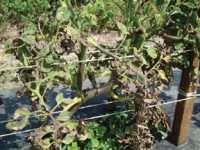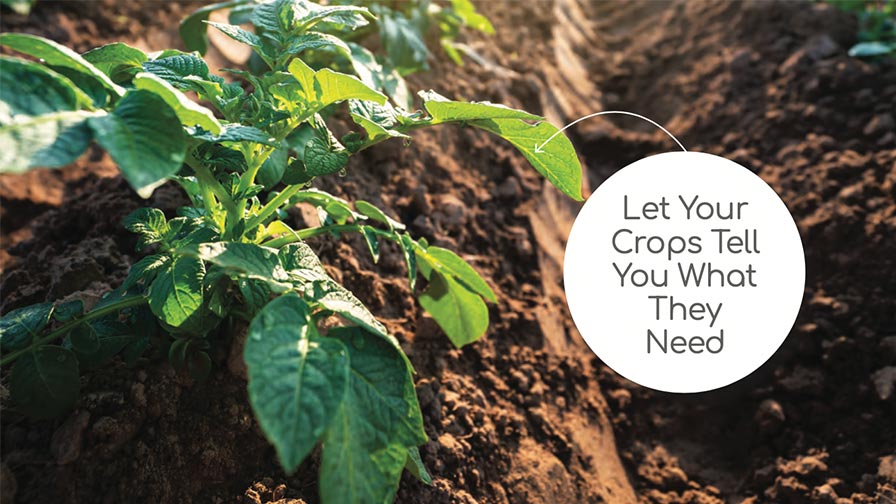Up To The Challenge Of Fighting Disease

Bacterial diseases caused by Xanthomonas and Pseudomonas species are just some of the challenging production issues that Florida tomato and pepper growers contend with. Florida’s subtropical environment is ideal for the rapid development of bacterial diseases. Rapid field-to-field spread of both pathogens is favored by large production acres concentrated in several regions of Florida.
Widespread tolerance to copper among these bacterial pathogens has greatly reduced the usefulness of copper-based compounds. Copper tolerance not only limits disease management in field production, but also in commercial transplant facilities. The use of infected transplants circumvents grower efforts to exclude these pathogens from their fields through elimination of likely sources of inoculum. In addition, both groups of pathogens are seed borne. So seed not only plays a role in initiating seasonal outbreaks, but also likely serves as a means for the movement of exotic strains — an area of current research.
Bacterial Diversity
In Florida, X. perforans is the predominant cause of bacterial spot on tomato. However, X. euvesicatoria, X. vesicatoria, and X. gardneri are additional species that can cause bacterial spot on tomato in other regions. Neither X. vesicatoria nor X. gadneri has been found in Florida. X. euvesicatoria is the principal cause of bacterial spot on pepper, and was once predominant on tomato in Florida until it was displaced by X. perforans. These four species were formerly classified as X. campestris pv. campestris. It’s only through the use of genetic and serological techniques that researchers were able to differentiate these four xanthomonads, although they vary in regards to host range and the disease symptoms associated with each.
Developing durable resistance to bacterial spot in tomato and pepper cultivars has been a challenge. While resistance to bacterial spot exists in tomato, efforts to develop resistant cultivars have been thwarted by sudden changes in the pathogen population. Commercial resistance to bacterial spot is available for pepper, but only confers protection to specific strains (often referred to as races) of the pathogen. Pepper cultivars with resistance to races 1 through 5 are commercially available.
Spots And Specks
Pseudomonas syringae pv. tomato is the causal agent of tomato bacterial speck on tomato. Symptoms of both bacterial speck and spot affect the foliage, stems, petioles, inflorescent tissues, and fruit of tomatoes. Symptoms of speck and spot can be tricky to differentiate in the field, but lesions of bacterial speck are usually surrounded by a prominent chlorotic (yellow) halo. Outbreaks of bacterial speck are most frequent during the spring when temperatures are mild.
Several other pathogenic Pseudomonas species occasionally cause problems on tomatoes in Florida, such as P. corrugata, P. viridiflava, and P. syringae pv. syringae. Symptoms of P. syringae pv. syringae can look quite similar to those caused by P. syringae pv. tomato, while those caused by P. viridiflava lead to large necrotic lesions with little chlorosis.
P. corrugata causes pith necrosis on tomato consisting of a deterioration of pith tissues that may lead to wilt and plant death. Typically diseases caused by P. corrugata, P. syringae pv. syringae, and P. viridiflava only occur during unusually long spells of cold, wet weather. Pseudomonas species are not typically associated with any diseases of pepper in Florida. However, in northern production areas, P. syringae pv. syringae can cause a foliar blight on pepper.
Managing Success
Exclusion is the best tactic to manage bacterial diseases caused by species of Xanthomonas and Pseudomonas on tomatoes and peppers. The use of field rotations, the destruction of infected crop debris, volunteers, and weeds, and the use of healthy, disease-free transplants will minimize the amount of inoculum in the field at the beginning of the season. Refraining from field activities when the plant canopy is wet, using resistant cultivars if available, and making timely applications of bactericides will reduce the spread of bacteria throughout the plant canopy and field.
Numerous studies have demonstrated the use of additional protective compounds and biological control agents for the suppression of bacterial diseases on tomatoes and peppers. Unfortunately, few of these alternatives have demonstrated a consistent improvement in disease management over the standard application of copper + mancozeb/maneb.
Resist Reliance
While additional bactericides may soon be available, history has taught us that relying on any specific bactericide quickly leads to the development of resistance. To maintain the usefulness of these bactericides will require the development and adoption of a resistance management plan. The goal is to prevent the development of resistance and to reduce the selective pressure on copper bactericides.
Unfortunately, bactericides — like most fungicides — are only preventative by nature. Even the best bactericidal treatment offers only limited protection when environmental conditions are favorable for rapid disease development. While tomato and pepper varieties with improved resistance are in development, there always will be a need to employ sanitary measures and various protective materials to manage bacterial pathogens.








